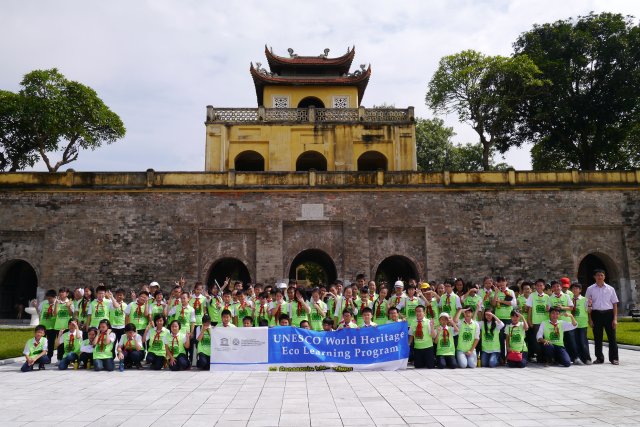
Dec 13, 2022
- Sustainability
- Feature Story
- Panasonic GREEN IMPACT
- India, Middle East and Africa

Panasonic conducts a variety of educational programs including the Kid Witness News Program, the Eco Picture Diary Contest, the Jump Rope Competition and the Global Eco Learning Program under the umbrella scheme of "Panasonic Kids School," in which over 460,000 children currently take part worldwide. In this article we introduce the UNESCO World Heritage Eco Learning activity that Panasonic organized for secondary school students in Hanoi in August.
In the hopes of promoting the sound development of children and mutual understanding among people around the world, Panasonic will continue in its work to promote and expand these activities in the future.
During 2 days on 9 and 10 August, at Central Sector of the Imperial Citadel of Thang Long – Hanoi (Thang Long Imperial Citadel), Panasonic Vietnam in cooperation with UNESCO's Office in Hanoi organized the Eco Learning program on UNESCO World Heritage for students of secondary schools in Hanoi.
Representatives from the Ministry of Education and Training participated to the program as well as UNESCO's office in Hanoi, Thang Long Imperial Citadel conservation center, over 400 teachers and students of Trung Vuong, Lomonosov, Hai Boi, Dong Hoi secondary schools.
Construction work for the National Assembly building in 2003 uncovered large remains of the Imperial Citadel of Thang Long. The citadel was constructed earliest in 1010 and remained the seat of the Vietnamese court until 1804. It was constructed on the remains of various periods in history, and the excavation is still continuing.
They have learned the features of history as well as the mechanism of a well which wells up naturally purified water even now, and its characteristic brick decoration which can only be seen in Citadel of Thang Long.
Environment pollution directly affects well water and remains. Excavation work at imperial Citadel of Thang Long was done with a roof specially provided to protect the well and remains from temperature and rain, and also with an enclosure because the sweat from people touching the remains has a harmful influence on preservation of the remains.
Ms.Huong from Panasonic Vietnam gave children a lecture in the "UNESCO World Heritage Eco Learning Program", a program where children learn about World Heritage and global environment. Children were given quiz on a screen in the lecture. They aggressively participated in the lecture and learned about the feature of the sites, number of listed sites and to protect World Heritage results in protecting global environment.
As you can see in the picture below, children drew what they've learned on a big piece of paper, and made a presentation of their work in the last workshop. While drawing, they thought of what they can do to protect the World Heritage site.
To learn about the World Heritage fosters creativeness of children all over the world Collaboration of UNESCO and Panasonic sends a strong message to the world of preserving World Heritage sites by protecting the environment. Especially, children’s interest in Imperial Citadel of Thang Long is also meaningful to adults because it is a special heritage in Vietnam.
Aiming at becoming the No.1 Green Innovation Company in electronic manufacturing industry by 2018, year celebrating the 100 years of the Group, Panasonic does not only innovate in technology to produce greener products for a better life but also to raise higher the sense of responsibility to protect the environment as a prerequisite for sustainable development.
In partnership with UNESCO, in parallel to the Eco Learning program, Panasonic also conducted a special global program - "Media training for young documentalists". The program involves training volunteer staff in photography and editing technical skills using Panasonic equipment and promoting global activities of World Heritage Volunteer program. The program collects data with a view to preserving World Heritage sites and the importance of leaving this behind in the form of visual images for the next generation.
The content in this website is accurate at the time of publication but may be subject to change without notice.
Please note therefore that these documents may not always contain the most up-to-date information.
Please note that German, French and Chinese versions are machine translations, so the quality and accuracy may vary.